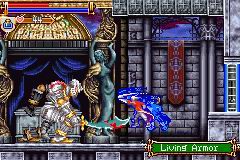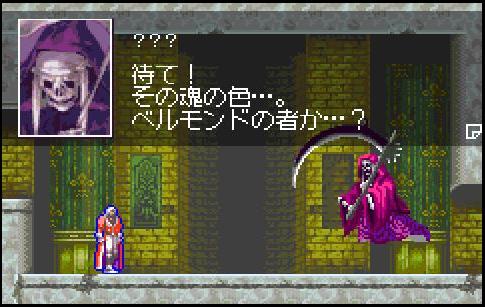 |
Castlevania: Harmony of Dissonance - Review |
 |
Watered-down
By: Phillipe Richer
| Review Breakdown |
| Battle System |
5 |
| Interface |
7 |
| Music/Sound |
4 |
| Originality |
6 |
| Plot |
3 |
| Localization |
4 |
| Replay Value |
6 |
| Visuals |
9 |
| Difficulty |
Very Easy |
| Time to Complete |
6-10 hours
|
|
| Overall |
 |
| Criteria
|
After the success of Castlevania: Circle of the Moon (CotM), Konami decided to stick with the GBA in releasing a new addition to one of the longest running series in videogame history. Fans of the widely popular Castlevania: Symphony of the Night (SotN) for PSX still weren't completely satisfied with the latest incarnation though, and Castlevania: Harmony of Dissonance (HoD) promised to mesh the best of the two RPG inspired side scrollers. While the visuals will certainly rekindle fond memories, the entirety of the game seems to have strayed away from what made the previous entries so enjoyable.
It's hard to pin-point exactly what went wrong when the creators sat down to craft HoD, but I simply didn't enjoy my playthrough as much as I did when I played other Castlevania games. This time, the game stars Juste Belmont, the descendant of Castlevania hero Simon Belmont. Juste's friend Lydie has been taken away and along with his friend Maxim, Juste goes on a quest to discover Lydie's location. Both friends miraculously stumble upon a strange castle in the mountain top, a castle which could only have been Dracula's past residence. However, for the first time ever (to my knowledge at least), Dracula is nowhere to be seen. That in itself doesn't mean much as to why HoD doesn't succeed, but it's still a small part of the explanation. Castlevania games, especially the two previous incarnations, have always been about three key aspects: gameplay, exploration, survival. With subtle variations and stupid innovations, Konami has actually succeeded in creating a Castlevania game that is just barely fun, and we all know that was the major thing the series had going for it.
On the surface, the game plays exactly like the two latest titles. You use your deadly whip to trounce enemies and to discover new relics which give you access to a bigger portion of the castle. The castle looks gorgeous, and navigating it is a breeze with the excellent map and the bright backgrounds. You'll have six different sub-weapons at your disposal, and a couple more tricks in the old bag. Juste can quickly dash forward or backward by pressing either L or R, making the bait-and-kill technique an important part of your abilities. Also, when you hold down the attack button, the whip will become numb and pushing the D-pad will move the whip in the given direction. This is great when you want to either cover yourself by spinning the whip in all directions or even letting it hang like a fishing rod to injure enemies below. You'll find several whip upgrades inside the castle, upgrades which add elemental properties, attack power, a charge option, or the ability to spin the whip indefinitely. Up to this point, nothing could be better.

|
| So big, yet so easy to bash to a pulp.
|
|
Here comes a fragment of the vase. The very intriguing and ingenious DSS system found in CotM is gone. The magic system now consists solely of five spell books. When activated, the spell book combines with your current sub-weapon to create a more powerful attack. The process consumes MP instead of Hearts and the results are usually fun to watch, although not very useful. The different books are scattered around the castle, and finding them won't bring you as much joy as finding a new card did in CotM. It's much too simplistic, and much too useless to warrant any consideration when playing. I personally stuck with the same sub-weapon/book combination for 3/4 of the game, because you have no need whatsoever to adapt to the new environments or enemies. You don't need a barrier of ice to block the boss' projectiles, you won't feel pressured to use a whip extension magic, and you sure as hell don't have to turn on the invincibility to get to the closest save point. The magic system in HoD is nothing but a gimmick that has been treated as an afterthought.
Even worse, every item and relic is in plain sight. Aside from a few fake walls, everything can be found by examining the map closely. And while there is a second castle, that mirror building consists of exactly the same layout. In fact, the maps of both castles overlap each other. The only changes are the background colors and the enemies. So, as if you weren't going to spend enough time back-tracking in one castle you'll have to do the same thing in another one. It's a cheap excuse to make up for the shortness of the game.
But the biggest problem of HoD, is without a doubt its difficulty. It is one of the easiest Castlevania game ever. Enemies are a real joke and the bosses don't even deserve such a title. They are usually too big to do anything, and every enemy attack pattern is laughably predictable. One boss is actually just a huge ball of mud that takes up 3/4 of the room. All you have to do is hit it forever, and it doesn't attack at all! It only spits out a couple of slow-moving worms once in a while, and letting your whip dangle until they run into it will take care of the problem. That's only a small example, but gone are the heart-wrenching battles, the terrifying expeditions and the much needed survival instinct factor. You also collect money hiding being candlesticks and use your cash to purchase a butt-load of recovery items, making your playthrough even easier. You'll just dash around flailing your whip without ever giving much thought to what you're doing, and that's not what previous Castlevania games have prepared us for.
The game can now be saved at anytime too, aside from story events and boss battles. When you load your game from a (permanent) quicksave, you'll be brought back to the last save point you've visited, with all the EXP and items you had acquired before saving. While it's a welcome addition, that aspect kills off any difficulty the game could've presented, and it didn't have a lot to propose to begin with. If you're ever in a jam, which won't happen, just quicksave, reload, heal, and continue. I think the most efficient and simplest way of introducing a quicksave would've been to create a temporary save file which would let you start back at the beginning of the room, thus taking away that extra safety cushion. There are simply too many things done wrong to make this a top-notch game.

|
| Although these two have never met before they sound like the greatest of pals. |
|
The Castlevania series has always been reputed for its engaging and exciting soundtracks. HoD once again refuses to stick with the family tradition and proposes one of the biggest mess my GBA has had the displeasure of blasting out. The sound quality is terrible, and melodies seem to date back to the NES era. It's so disharmonious and bland that you'll dread turning the speakers up. Both SotN and CotM presented some very nice melodies and some very pleasing music, but the creators clearly stated that they weren't going to spend much time on the music department. They definitely kept their promise.
In contrast, sound effects have been pushed a step up. The sounds of enemies crumbling to dust and spells being thrown left and right might just pique your interest enough to lay down your MP3 player. The game also features some subtle Japanese voice-acting, mostly battle cries, but they all sound very appropriate.
Making a small departure from the usual "Dracula has been resurrected: kill him" storyline, the plot in HoD is as shallow and non-existent as you would expect. However, there are a couple of surprising revelations here and there, and while the whole thing might not hold up it's still a worthy effort. You're at least given an explanation as to why the castle has re-emerged and been split into two sections, which is more than any previous game offered. But still, no one reads Castlevania reviews to find out about the plot, right? Right.
There's as much text in this one as there is in a children's book. During the few sequences where they actually speak, characters seem to try and give out a sense of personality, but it's all in vain. Sentences either sound too casual or try to feel more medieval-ish with their awkward sentence structure, and all and all it's just a sorry excuse to hold whatever plot the game presents. I still understood the story though, which is more than I could've accomplished if it was in Japanese.

|
| You'll hear the name Dracula often, but you'll never actually see the poor sucker. Get it? |
|
CotM offered the option to play the game in a totally different mindset of character strength for subsequent playthroughs, and HoD also does to some extent. Once you finish the game, you can play as Maxim (much like SotN let you play as Richter), which provides a slightly enjoyable alternative to your whip tooting companion. You may also play in ``Hard Mode``, although I doubt the game could provide any challenge at all the way the mechanics work. Again, there are practically no secret rooms to be found, so you can forget about discovering new locations, unless you avoid them on purpose during your first playthrough. While I finished CotM four times already, I doubt I'll ever play through HoD as many times.
Unfortunately or fortunately for us, the biggest attraction the game offers is in the visual department. Don't get me wrong, I absolutely adore impressive artistic displays in my games, it's just that I buy Castlevania games for the gameplay they offer, not for the eye-candy. But it's still a marvel to look at. Enemies are now huge, colorful, and highly detailed. The fluidity of both Juste and his foes is quite impressive, and spell effects look incredible. It's also much less dark than CotM was, easing things up for your eyes quite a bit. What I found the most dazzling is the quality artwork shown by the backgrounds. You always get a distinctive look for every part of the castle and there are always two or more layers of backgrounds. It's amazing to look at, especially when you see those life-like clouds floating about in the Corridor of Air. However, one can't help to wonder how much better those multiple layers could've been used to enhance the gameplay. For example, some bosses or enemies could've had the ability to hide behind structures and reappear from the shadows to attack you from the back. More polishing couldn't have hurt.
In the end, HoD is not as intriguing or challenging as the other games in the series. It's also a less memorable experience, probably due to the fact that you can complete the game in a state of semi-consciousness. The lack of difficulty is strictly unforgivable, but if you're a newcomer to the series that might just be the best game to start with. The hardcore gamers will be disappointed though.
|










